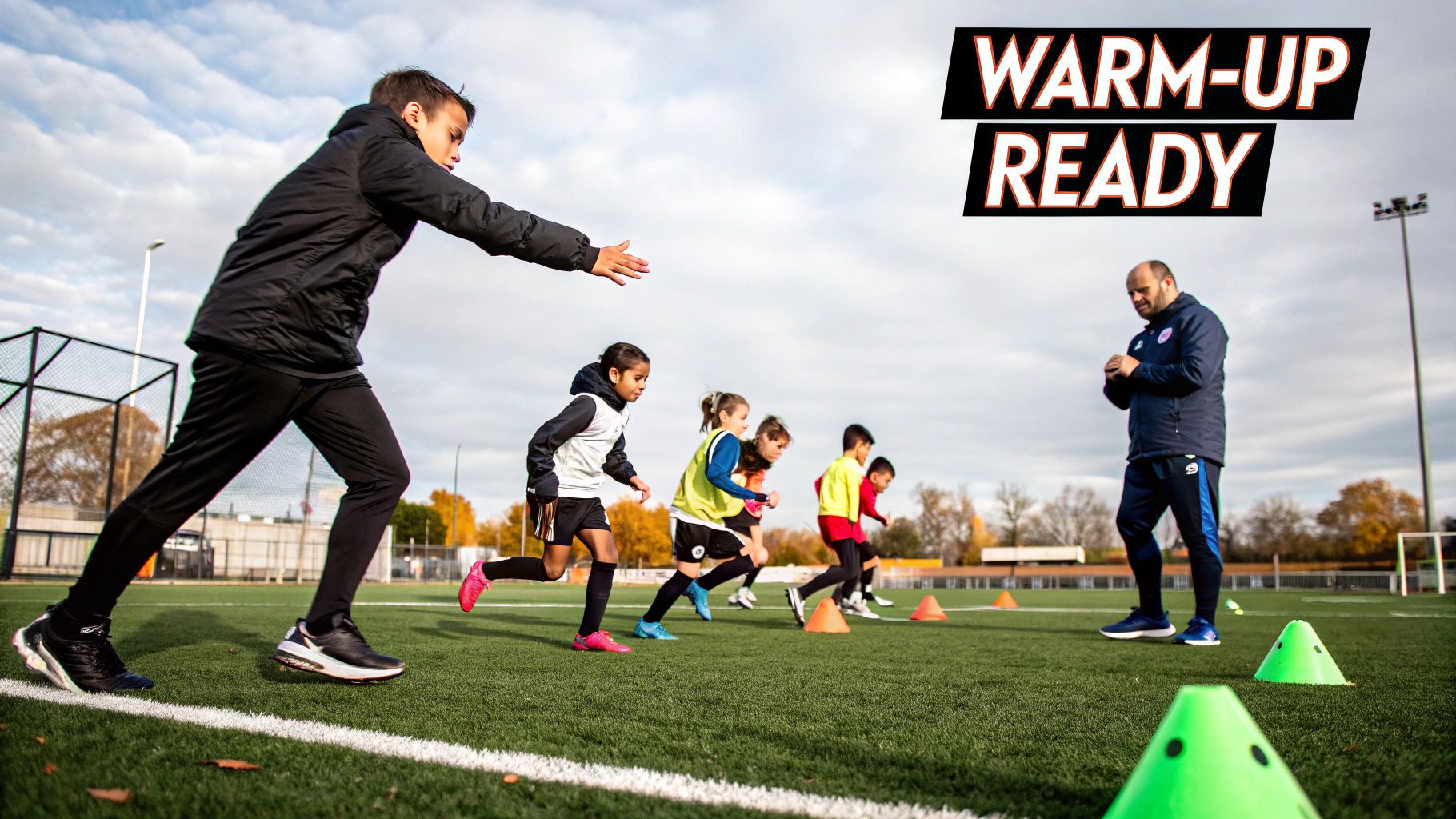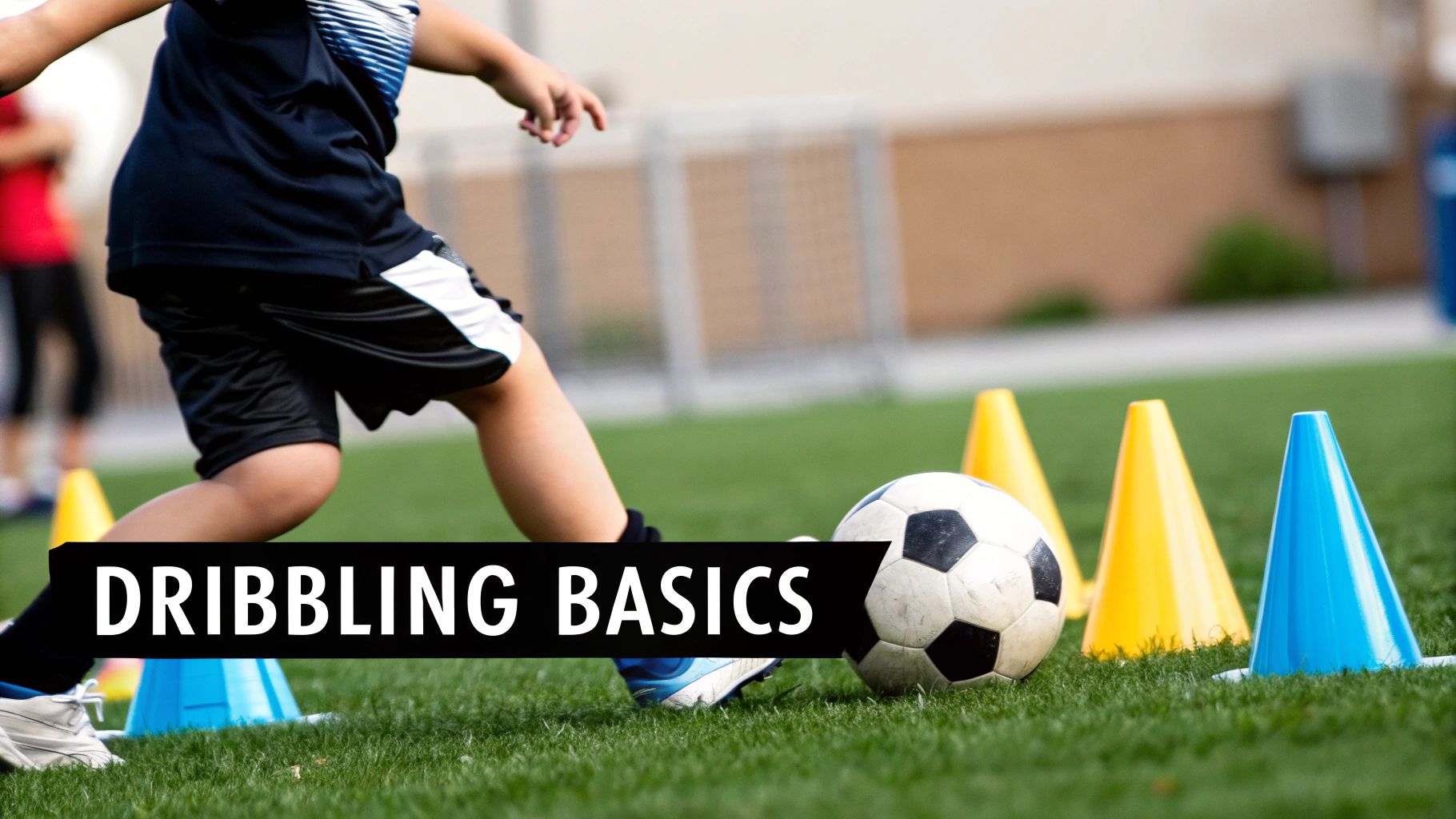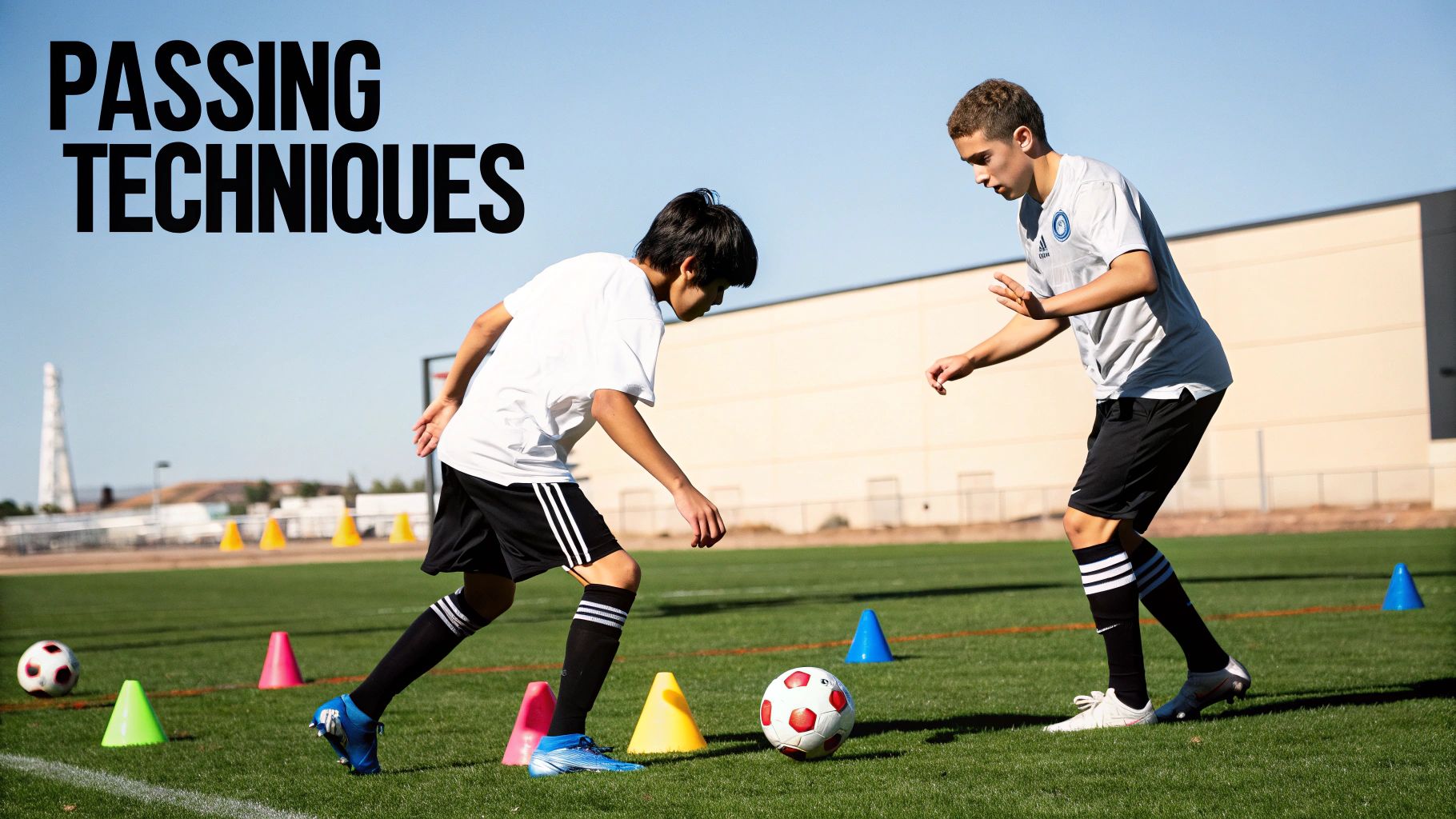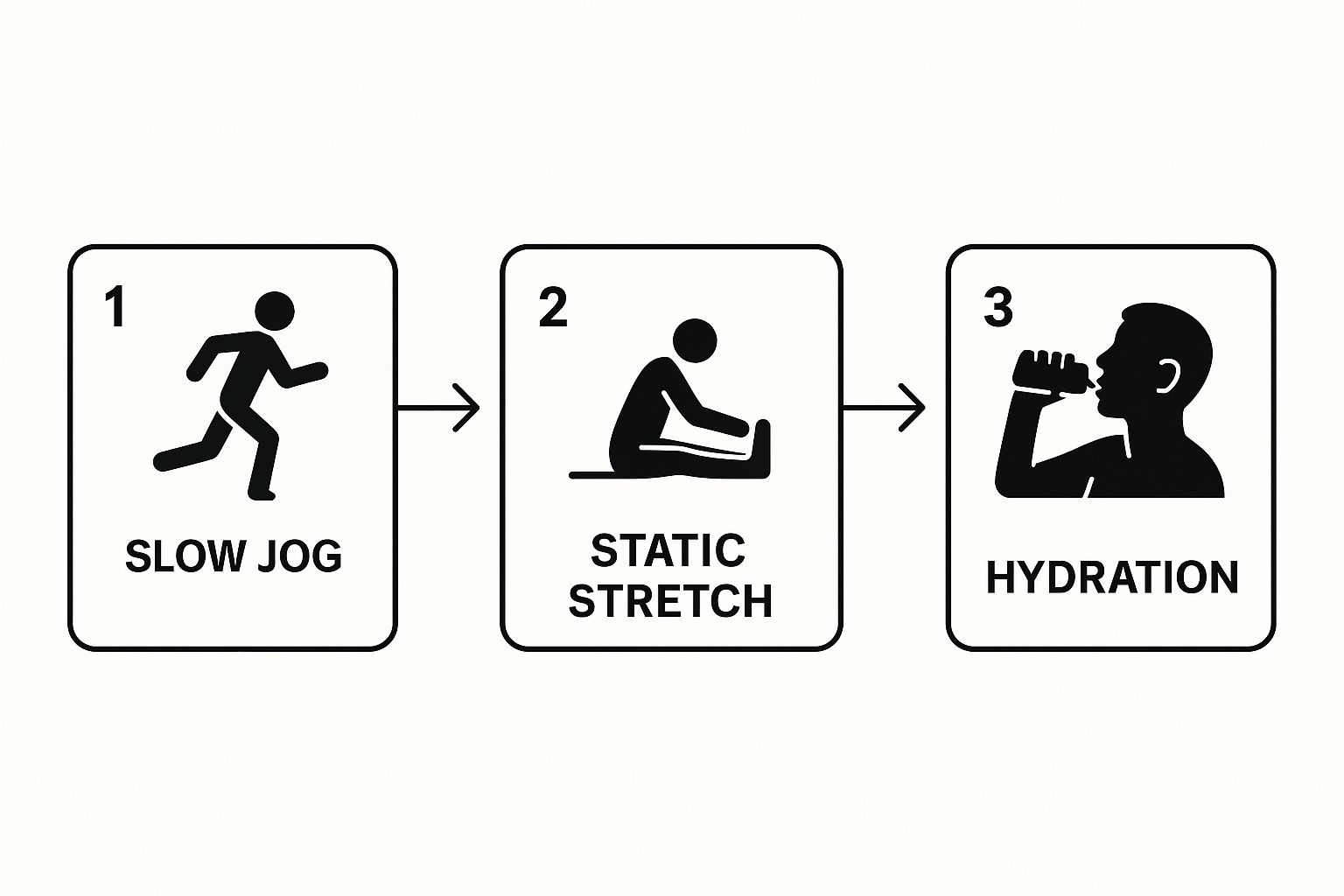Beginner football drills are your bread and butter. They’re simple, repeatable exercises designed from the ground up to build foundational skills like dribbling, passing, and shooting. The whole point is to master ball control and coordination—the absolute essentials for any new player looking to feel more confident on the pitch.
Building Your Foundation with Core Football Skills

Stepping onto the pitch for the first time is a brilliant feeling, but it’s easy to feel a bit lost. Where do you even start?
Before you dream of hitting a top-corner free-kick, you need a solid foundation. This starts with the core skills every player relies on, from Sunday league heroes to Premier League stars. These are your tools for the game, the simple actions that make a genuine difference in how you play and how quickly you improve.
To give you a clear roadmap, here’s a quick look at the core skills we'll focus on and the types of drills that build them.
Core Skills and Their Foundational Drills
| Core Skill | Beginner Drill Example | Key Benefit |
|---|---|---|
| Ball Control | First-touch drills | Improves your ability to receive a pass and prepare for your next move instantly. |
| Dribbling | Cone weaving | Develops close control while moving, helping you navigate tight spaces. |
| Passing | Wall passing or partner drills | Builds accuracy, timing, and the ability to connect with teammates. |
| Shooting | Stationary target practice | Hones your technique for striking the ball cleanly and on target. |
These drills aren't fancy, but they are the bedrock of good football. Mastering them is the first and most important step in your journey.
What Are the Foundational Skills?
For any beginner, the journey should start by focusing on four key areas. Don't try to learn everything at once. Just dedicate your time to getting comfortable with these.
- Ball Control: This is all about your first touch. It’s your ability to receive the ball and keep it close, giving you the time and space to decide what to do next without panicking.
- Dribbling: This is the art of moving with the ball at your feet. It's more than just running—it’s about keeping possession while navigating the pitch and spotting opportunities.
- Passing: Football is a team game, and passing is how you connect with everyone else. An accurate, well-weighted pass is the lifeblood of any good team.
- Shooting: At the end of the day, it's about scoring goals. Developing a confident and accurate shot is what turns your good play into points on the scoreboard.
The real secret isn't learning a hundred different moves. It's doing a few simple drills a hundred times until they become second nature. Consistency is what separates good players from great ones.
Essential Gear for Your First Drills
You don’t need a lorry full of expensive equipment to get started. In fact, keeping it simple lets you focus purely on your technique.
All you really need is a quality, correctly-sized football and some open space. A simple set of cones will be your most valuable training partner, helping you set up countless drills for dribbling and control. For reliable practice gear, check out the training essentials at SoccerWares.
With that basic setup, you have everything you need to start building your skills. This accessibility is a huge reason for the sport's popularity. In England, football remains the top sport for children, with around 40 percent of kids aged 5 to 16 taking part in the 2023-24 school year. You can find more insights on youth football trends over at Statista.com.
Mastering Control with Foundational Dribbling Drills

Great dribbling isn't about fancy tricks. It's about making the ball feel like an extension of your own body, allowing you to glide past defenders, move confidently across the pitch, and create chances to pass or shoot.
That kind of close control comes from thousands of soft, deliberate touches that build muscle memory. Think of it like learning to type without looking at the keyboard—eventually, your feet just know where the ball is. This section breaks down the essential beginners' football drills that will help you build that vital connection.
The Anatomy of a Good Dribble
Before we jump into the drills, you need to understand the "how." Solid dribbling means using different parts of your foot for different situations. Each surface gives you a unique way to control the ball.
- Inside of the Foot: This is your go-to for control and short passes. Use it for gentle nudges to keep the ball glued to you while moving slowly or shifting direction.
- Outside of the Foot: Perfect for pushing the ball forward when you're sprinting or need to make slight adjustments without breaking stride. It feels much more natural when you're running at pace.
- Laces (Instep): This is for knocking the ball further ahead into open space, letting you run onto it at speed. It's more of a "knock-and-run" touch than a dribble.
For any beginner, the main focus should be on the inside and outside of the foot. Get comfortable with those two surfaces, and you’ll have the control you need for almost any situation on the pitch.
Drill One: Simple Cone Weaving
This is the classic, must-do drill for any aspiring player. It's the bread and butter of dribbling practice because it directly translates to navigating a crowded midfield or weaving past a defender. All you need is a straight line of cones.
How to Set It Up:
- Place five to eight cones in a straight line, leaving about one metre of space between each. You can find durable, brightly coloured training cones at soccerwares.com that are perfect for this.
- Start at one end and weave through the cones using only the inside of your right foot. The key is small, frequent touches.
- When you get to the end, turn around and come back, this time using only the inside of your left foot.
- Next, repeat the whole thing, but use the outside of your right foot on the way down and the outside of your left on the way back.
Your goal here isn't speed—it's control. Try to keep the ball within a foot of your body the entire time. As you get more comfortable, start lifting your head up for a second at a time to scan your surroundings.
A common mistake I see beginners make is kicking the ball too hard and having to chase after it. Dribbling is about guiding the ball with soft taps, not kicking it. Imagine the ball is tied to your boot with a short piece of string.
Progressing Your Dribbling Skills
Once you feel confident with the basic cone weave, it's time to introduce some variations to challenge yourself. Progression is what turns a basic skill into a great one.
Next-Level Variations:
- Tighten the Cones: Move the cones closer together. This will force you to take quicker, smaller touches and make sharper turns, just like you would in tight spaces on the pitch.
- Random Cone Placement: Instead of a straight line, scatter the cones randomly in a small grid. Dribble between them in no particular order. This makes you constantly change direction and, crucially, keep your head up to decide where to go next.
- Introduce a "Defender": If you have a friend, get them to stand still as an obstacle. Now you have to dribble around them. It adds a much more realistic element of avoiding an opponent.
Each of these simple drills reinforces the core principles of ball control. If you commit to these foundational exercises, you'll build the confidence to keep the ball at your feet, no matter what the game throws at you.
Developing Precision with Passing and Receiving Drills

If dribbling is a monologue, passing is the conversation that turns football into a team sport. It’s the language players use to connect, create chances, and ultimately control the rhythm of a match.
For any beginner, getting the simple push pass right is one of the most important first steps. This section breaks down both sides of that conversation: delivering a crisp, accurate pass and receiving the ball with a clean first touch. Master these, and you’re well on your way.
The Push Pass: Cornerstone of Team Play
The push pass is your bread and butter. It’s the most reliable way to move the ball between teammates, and it’s all about precision, not raw power. The aim is to send the ball smoothly along the ground, right to your target’s feet.
To pull it off consistently, your body shape and technique are everything. Here’s what to zero in on:
- Non-Kicking Foot: Plant this foot right beside the ball, pointing exactly where you want the pass to go. This gives you balance and aims your entire body.
- Locked Ankle: Keep the ankle of your kicking foot firm and locked. A floppy ankle is the number one cause of weak, inaccurate passes.
- Contact Point: Use the inside of your foot to strike the very centre of the ball. Think of it as a firm push rather than a kick.
- Follow-Through: Your kicking foot should follow through in a straight line towards your target. This is what keeps the pass true.
Nailing these mechanics is the foundation for almost every passing move you’ll ever make.
Practice Drills for Passing and Receiving
The only way to get better is through repetition. These simple beginners' football drills are perfect for building that all-important muscle memory, whether you’ve got a partner or you’re practising on your own.
Partner Passing Drill:
Stand about five to ten metres away from a partner. Just focus on passing the ball back and forth, concentrating completely on your technique. Aim to make every pass firm, accurate, and easy for your partner to control.
The Wall: A Relentless Training Partner:
If you're training solo, a brick wall is your best friend. It never gets tired and always sends the ball back. Stand a few metres away and just practise passing against it. You can get hundreds of touches in a short space of time, making sure to alternate between your right and left foot.
The quality of your first touch determines how much time you have to make your next decision. A soft, controlled touch buys you space and composure; a poor one invites immediate pressure.
The Art of the First Touch
Receiving the ball is every bit as important as passing it. A good first touch kills the ball’s pace stone dead and sets you up for your next move—whether that’s another pass, a dribble, or a shot.
As the ball comes towards you, look to cushion its arrival with the inside of your foot. The secret is to slightly withdraw your foot right on impact, absorbing the ball's energy like a pillow. The goal is to have the ball stop just in front of you, perfectly positioned for whatever you decide to do next.
Combining these passing and receiving drills into your routine is crucial. The great thing is, football's popularity means you can see these skills being practised in parks and clubs everywhere. In the UK alone, an estimated 11 million people are actively involved in the sport, from casual kickabouts to organised teams. You can find out more about grassroots sports participation at Spond.com.
By really focusing on these foundational techniques, you’ll build the confidence to become a reliable and effective teammate.
How to Shoot a Football with Confidence
Let's be honest, scoring a goal is the best feeling in football. It all comes down to a confident shot. For new players, the temptation is to just smash the ball as hard as you can. But real confidence comes from technique, not just brute force. It’s about learning to strike the ball cleanly so you get that perfect mix of power and accuracy.
This guide will walk you through the mechanics and drills you need to turn hopeful kicks into genuine goal threats. We’ll start right at the beginning with a stationary ball before getting into more realistic, in-game situations. To get the most out of your practice, you need a ball you can rely on. If you're looking for consistency, check out the range of high-quality footballs at soccerwares.com.
Perfecting Your Stationary Shot
Before you can score on the move, you have to get the basics right with a dead ball. This drill strips away all the other distractions—dribbling, movement, defenders—and lets you focus purely on your striking form. Think of it as building the engine for your shot.
Here's a simple breakdown of a clean strike:
- Plant Your Foot: Your non-kicking foot is your anchor. It dictates everything. Place it firmly beside the ball, with your toes pointing exactly where you want the ball to go. This simple act aligns your entire body for the shot.
- Lock Your Ankle: A floppy ankle is the enemy of a powerful shot. Keep the ankle of your kicking foot rigid and locked. This is probably the number one reason young players lose power and accuracy.
- Strike with Your Laces: For a powerful, driven shot, you want to connect with the hard, bony part on the top of your foot—your laces. Aim to strike right through the centre of the ball.
- Follow Through: Don't stop at impact. Your kicking leg should swing through the ball and continue towards the target. The follow-through is where so much of the power is generated.
Drill Progression: From Still to Moving
Once you're comfortable hitting a stationary ball cleanly, it's time to add a bit of movement. After all, you rarely get a perfect, still setup in a real match. This progression is designed to build on your technique step by step.
Level 1: The First Touch Shot
Get a teammate or a parent to pass you the ball from about 10 metres out. Your job is to take one touch to control it and pop it into space, then hit it with your second touch. This drill is absolutely crucial for learning how to get a shot off quickly when the pressure is on.
Level 2: Dribble and Shoot
Place a cone about 15 metres from the goal. Dribble towards it, do a quick step-over or a feint to get past it, and then take your shot. This simulates beating that last defender and immediately looking for the finish.
Remember, the best strikers don't just shoot hard—they shoot smart. They focus on placing the ball in the corners, away from the goalkeeper. Accuracy will always beat pure power.
There's a reason club-based activities are so popular for young players. Structured coaching is the fastest way to develop these skills. In the UK, club activities account for about 52% of youth sports involvement, providing the perfect environment to master these drills. You can read more about it in this report on UK youth sports engagement.
Put in the time with these drills, and you'll go from someone who just kicks the ball at the goal to a player who shoots with real purpose and confidence.
Creating Your First Football Practice Routine
Real improvement in football doesn’t come from a random kickabout in the park. It comes from consistent, focused practice. Having a structured routine gives you a clear roadmap to getting better, balancing all the core skills without it ever feeling like a chore.
The whole point is to build a sustainable habit you actually enjoy. A well-rounded routine stops you from only practising the stuff you’re already good at. It forces you to spend time on dribbling, passing, shooting, and even the basics of defending. By mixing things up, you develop into a more complete player and, just as importantly, you don't get bored.
Building a Sample Weekly Routine
When you're just starting, consistency beats intensity every single time. Aim for two or three focused sessions a week, each lasting about 45-60 minutes. This gives your body enough time to recover and your brain enough time to actually lock in what you've learned.
Here’s a simple structure you can steal for each session:
- Warm-up (5-10 mins): Get the blood flowing. Start with some light jogging, jumping jacks, and dynamic stretches like leg swings to wake your muscles up.
- Skill Focus (20-25 mins): This is the main event. Dedicate this block to one or two specific beginners' football drills. On Monday, you might focus on cone weaving for your dribbling. Come Wednesday, it could be wall passes to sharpen your first touch.
- Game Simulation (10 mins): Time to add a little pressure. Turn whatever you've been working on into a mini-game. If it's shooting, challenge yourself to score 5 goals from 10 shots. It makes practice feel more like a real match.
- Cool-down (5 mins): Don't skip this. Seriously. A proper cool-down is vital for preventing injury and making sure your muscles are ready for the next session.
This infographic breaks down the three essential steps for a solid cool-down.

Following this simple process of jogging, stretching, and rehydrating helps your body shift from high gear back to rest, which massively speeds up recovery.
Setting Goals and Staying Motivated
Seeing progress is one of the best motivators out there. Keep a simple training diary and set small, achievable goals. Instead of a vague target like "get better at dribbling," make it specific: "complete the cone weave drill three times in a row without losing the ball."
The best practice routine is the one you actually stick to. Make it fun, celebrate the small wins, and don't be afraid to mix in different drills to keep things fresh.
Once you start feeling more confident, you can begin to layer in more advanced drills. For players wanting to work on their positioning and tackling, you can explore a variety of defence soccer drills to add another dimension to your training. This structured approach will transform not just your skills, but your confidence on the pitch too.
Got Questions About Beginner Football Drills? We’ve Got Answers
Stepping onto the pitch for the first time brings up a lot of questions. It's totally normal. Here, we'll tackle some of the most common queries we hear from new players and parents, giving you clear, straightforward advice to get you started on the right foot.
How Often Should a Beginner Practise Football Drills?
When you're new to the game, consistency beats intensity every single time. Forget about trying to train like a pro from day one.
A great starting point is aiming for two to three sessions per week. Each session should be around 45-60 minutes long—enough time to get quality touches in and build muscle memory, but not so long that you burn out.
To keep things fresh, our advice is to pick one or two skills to focus on per session. Always wrap things up with something fun, like taking a few shots on goal. It ends practice on a high note.
What’s the Single Most Important Skill to Learn First?
If you could only master one thing to start with, make it ball control. Hands down. It's the foundation for everything else you'll do on the pitch.
Ball control isn't just about fancy dribbling. It's about your first touch when a pass comes your way, keeping the ball close as you move, and feeling confident with it at your feet. Without good control, making a clean pass or taking a decent shot becomes a real struggle. Drills as simple as weaving through a few cones are perfect for building this core skill from scratch.
The ability to practise on your own is a massive advantage for any player just starting out. Many of the most important beginner drills—like dribbling, juggling, or shooting against a wall—don't require a partner. That solo time is where you really start to develop a feel for the ball.
What Basic Equipment Do I Really Need to Start?
You don't need a locker full of expensive gear to get going. The essentials are actually pretty simple and won't break the bank.
Here’s what you truly need:
- A properly sized football (Size 4 for ages 8-12, Size 5 for 13 and up).
- A safe, open space to play in, like a park or your back garden.
- A basic set of training cones.
Honestly, those cones are probably the best investment you can make. They give your practice sessions structure and let you set up an endless variety of dribbling and agility drills. If you need more ideas on what to do in your sessions, check out our guide on essential soccer exercises for beginners.
At SoccerWares, we provide the high-quality training essentials you need to start your football journey with confidence. From durable cones to premium footballs, we have everything to support your development on the pitch. Find your perfect gear today at https://soccerwares.com.

